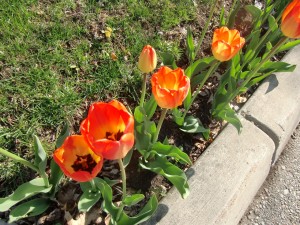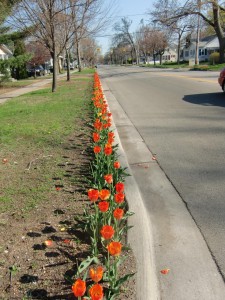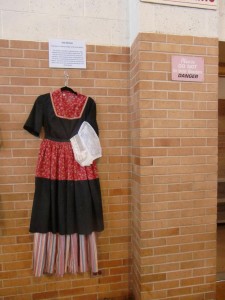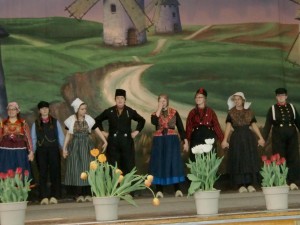TULIP TIME – HUNTING TULIPS
TULIP TIME
This is the fourth in a series of articles about seeing tulips and touring the state of Michigan
HUNTING TULIPS
By Charles N. Stevens
Photos by Dolores Seidman
On a clear, crisp morning we board the bus to hunt for tulips. We thought the flower would be ubiquitous in a town called Holland, but here we are, trying to find some. We drive down several streets where our guide assures us we would see a profusion of them, all of us craning our necks by the bus windows. As last, right along the curb of a suburban street, we catch our first glimpse of the elusive blooms. Some are barely out, others stunted, a few looking like weeds.
We get off the bus with our cameras, fanning out into the street to seek the best blooms. Apparently everyone on this street was required to plant tulips in their parkways along the curb. Possibly they decided to do it themselves as a community project. Actually, some of the rows were in full bloom, the people with cameras quickly gathering around them. We took several shots of some pinkish orange ones. If all the tulips had all fully matured, the street would have become quite colorful. But again, they blame the excessively cold winter for their late blooming. It is humorous to see photographers try all angles to get the best, most colorful photo, to make it seem as though tulips were everywhere. After all, that’s what we came all this way to see.
When all have taken their tulip pictures, the bus takes us into the Civic Center and Market Place. In a large hall or gymnasium are displays of Dutch products—cheeses, pickles, wooden shoes, Delft ware and souvenir items. Snacks are available, even apple pie a la mode. On the stage, a master gardener talks about the care and feeding of tulips and local citizens modeled old Dutch Costumes.
For a side trip, we bus out to the Dutch Village, a place where all kinds of Dutch ware and souvenirs as well as tulip bulbs are sold. For a fee of ten dollars a person can pass through a gate into fields of growing tulips. We chose not to go as the tulips were not in full bloom anyway. The most interesting event in the Dutch Village was the making of wooden shoes. Using a model of the shoe, a machine carves one out of a block of poplar wood. The operator then hollows it out on another machine. Woodchips and wood dust fly everywhere behind a screen, and the air is scented with the fresh smell of raw wood. They are for sale as souvenirs.
Back to “Tulip Time” at the Civic Center, we watch an exhibition of Klagen dancers wearing wooden shoes. The amplified strains of an accordion fill the hall. Again, to protect their feet, the dancers must wear six to eight pairs of socks to protect their feet from the hard wood. While the dancers cavort around the stage, I buy a lunch of potatoes mashed with kale and a meatball with gravy.
After lunch, Dolores and I head for the Pillar Church several blocks away. Four massive white columns grace the front of the church, and a pointed white steeple, looking much like those in New England rises from the top. It is a Dutch Reformed Church. An elderly woman dramatically talks about the church to some of us. That Church originated in 1571 and spread with the Dutch over many parts of the world, including the United States. It was the largest church in the Netherlands until 1930 when it merged with the Protestant Church in the Netherlands. As she speaks, we look up at the ceiling which reminds us of the inside of a boat. Perhaps the carpenters that built the church also built ships. When the talk is over, we walk downstairs where some of the church members serve us lemonade and cookies.
In town we sit on a bench near a patch of reddish tulips. They nod in the wind, making us slightly dizzy as we gaze at them. This was the richest growth of tulips we had yet seen.
Back at the Center, we watch a woman spinning yarn on a wheel from old Netherlands. I’m fascinated with how the yarn emerges from the bunch of “threads” she holds in her hand.
We eat an early dinner at Carino’s, an Italian restaurant in a “Dutch” city. We have a wonderful dinner topped off with luscious tiramisu. In the evening we rest.

In the morning we took photographs of our first tulip sighting.

Tulips bloom along the curbs for the length of this street.

This is a sample of one of the old Dutch costumes on display.

Local folks show us some of the old Dutch dances.
MONTEREY PARK AUTHOR PUBLISHES 4th BOOK – Seeking More of the Sky: Growing Up in the 1930’s:
Charles “Norm” Stevens, a 43 year resident of Monterey Park has recently published his 4th book: Seeking More of the Sky: Growing Up in the 1930’s. This is the story of a young boy growing up in Inglewood, California in the l930’s. This was a time during the depression when unemployment was affecting many and the banks were closed, while the clouds of war were gathering in Europe. But he was lucky enough to be raised in a loving family, the power of that love reflected throughout his stories.
Stevens is the author of three previous books about his experiences during WWII:
An Innocent at Polebrook: A Memoir of an 8th Air Force Bombardier (Story of his 34 bombing missions from his base at Polebrook, England over Germany and France)
The Innocent Cadet: Becoming A World War II Bombardier (A prequel to the first, telling of his training in the U.S. before going overseas into combat.)
Back from Combat: A WWII Bombardier Faces His Military Future from Combat: (This book details the time from when he returned from combat in England until the end of the war.)
He is known to the readers of The Citizen’s Voice as the author of Travel Log Articles including “Cruising the Rhine and Mosel”,” Best of the West”, “In Search of Snow” , “From Paris to Normandy on the Seine”, and “Exploring New York”. He is retired, having taught for 32 years, primarily in the Montebello Unified School District.
Those interested in purchasing an autographed copy of any of his books, may contact the author at 323-721-8230 or Normstevens24@gmail.com.



